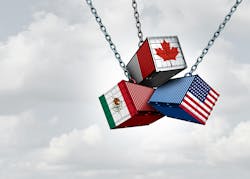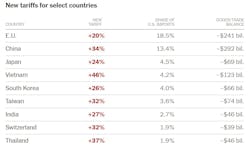Heard Enough About Tariffs Yet?
President Trump's tariffs and policies are numerous and seem to be ever-changing. Whether you like to listen, watch, or read, we have something to inform and engage from a variety of sister publications, which focus on everthing from chemicals to security, in addition to content from Electronic Design. These are designed to give you a better perspective on the impact of the tariffs across many industries, and issues that engineers and developers must contend with.
The response to Trump's tariffs has been a spate of reciprocal tariffs.
- Podcasts
- Videos
- Articles
- What’s Going On? Politics, Tariffs, Regulations and Beer @ Chemical Processing
- Tariffs on Food: A Cascading Threat to Food Safety, Quality and Legitimacy @ Food Processing
- 25% Tariffs Coming for All Imported Cars in April: DC Watch @ IndustryWeek
- Trump’s Executive Orders: Security industry insiders weigh in @ Security Infowatch
- Trump to Enact Tariffs on Canada, Mexico, Despite Business Community Opposition @ IndustryWeek
- Lindt May Shift Canada Chocolate Supply From U.S. Plants to Europe Because of Tariffs @ Food Processing
Reciprocal Tariffs Are a Response to U.S. Tariffs
The New York Times article. "‘Reciprocal’ Tariffs: See Which Countries Have the Highest Rates," presented a list of the latest reciprocal tariffs from different countries:
Of course, these numbers are just the latest. The shifting landscape is in response to Trump's tariffs and various negotiations that seemingly occur on a daily basis. What's covered and to what degree makes it almost impossible to do any long-term planning, let alone determine where one might build something.
Mr. Trump said that “If you want your tariff rate to be zero, then you build your product right here in America.” That may be a useful goal, but hardly one that can be done in the short term for things like semiconductors, automobiles, and bananas. I add the latter because growing bananas in the U.S. will require a bit more global warming to occur, along with a major change in farm work hiring. Bananas do grow in the U.S. and some are actually exported, but the majority are imported.
Fruit aside, the list of countries with reciprocal tariffs includes major supplies of semiconductors, including South Korea, Tawain, E.U., China, and Japan. Current U.S. tariffs don't apply to chips at this point. However, that could change, and the impact of tariffs in general will affect those prices simply due to the rising cost of supporting semiconductor production.
Supply Chain Connect - Podcast
Electronic Design - Inside Electronics Podcast
WaterWorld and Wastewater Digest
WaterWorld editors Bob Crossen, Mandy Criospin, and Alex Cossin summarize several actions of President Trump during his first month after reassuming the presidency and what those might mean for the industry. They touch on the nomination of Jessica Kramer as assistant administator for the office of water at the EPA.
Video with Industry Week, Power & Motion, and Electronic Design
About the Author
William G. Wong
Senior Content Director - Electronic Design and Microwaves & RF
I am Editor of Electronic Design focusing on embedded, software, and systems. As Senior Content Director, I also manage Microwaves & RF and I work with a great team of editors to provide engineers, programmers, developers and technical managers with interesting and useful articles and videos on a regular basis. Check out our free newsletters to see the latest content.
You can send press releases for new products for possible coverage on the website. I am also interested in receiving contributed articles for publishing on our website. Use our template and send to me along with a signed release form.
Check out my blog, AltEmbedded on Electronic Design, as well as his latest articles on this site that are listed below.
You can visit my social media via these links:
- AltEmbedded on Electronic Design
- Bill Wong on Facebook
- @AltEmbedded on Twitter
- Bill Wong on LinkedIn
I earned a Bachelor of Electrical Engineering at the Georgia Institute of Technology and a Masters in Computer Science from Rutgers University. I still do a bit of programming using everything from C and C++ to Rust and Ada/SPARK. I do a bit of PHP programming for Drupal websites. I have posted a few Drupal modules.
I still get a hand on software and electronic hardware. Some of this can be found on our Kit Close-Up video series. You can also see me on many of our TechXchange Talk videos. I am interested in a range of projects from robotics to artificial intelligence.


